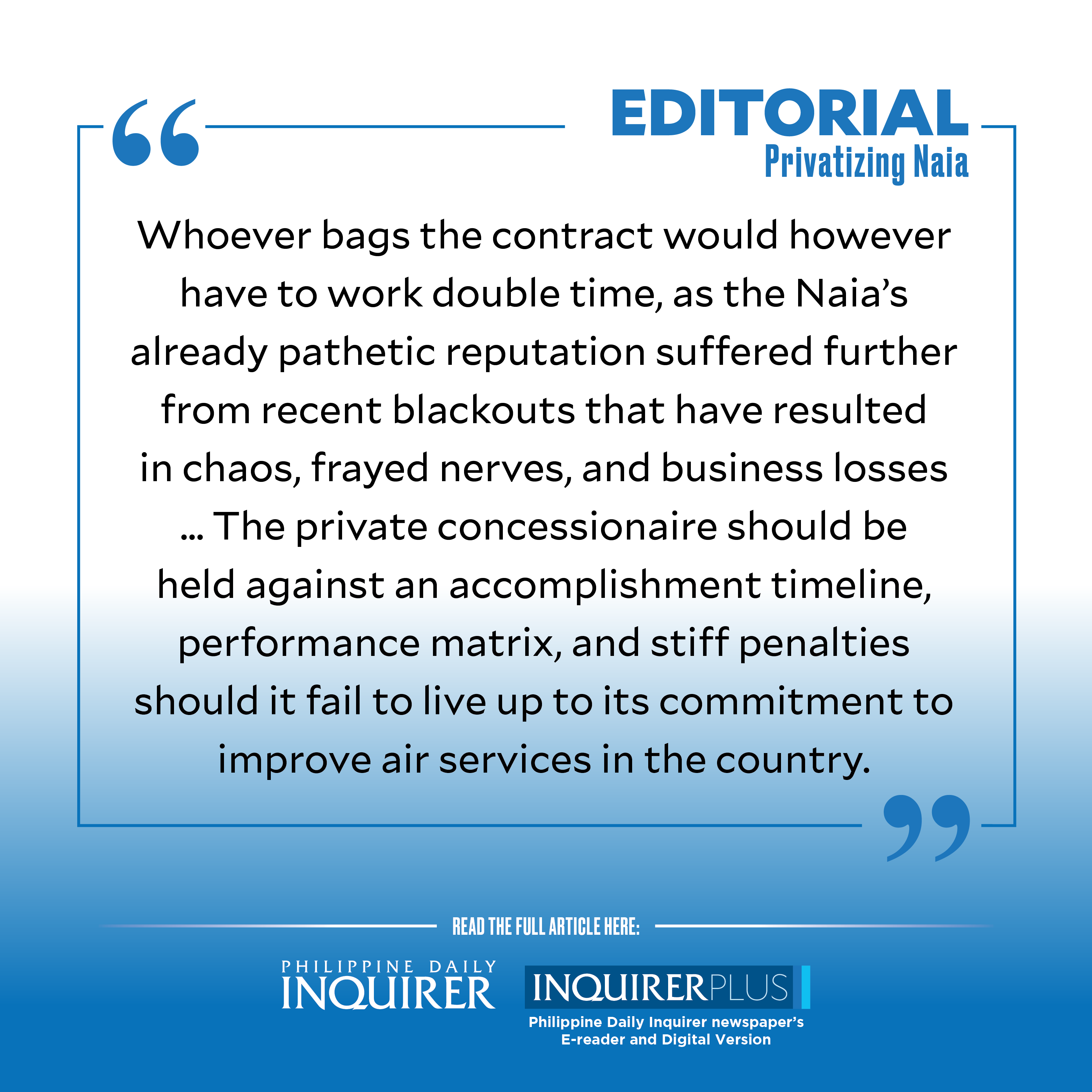
The prospect of the much-maligned Ninoy Aquino International Airport (Naia) graduating from the ignoble list of the world’s most stressful airports has vastly improved, following the Department of Transportation’s (DOTr) announcement that it was open to partnering with the private sector for its operations.
Last week, the DOTr and the Manila International Airport Authority (MIAA) submitted to the National Economic and Development Authority a joint proposal for a public-private partnership project involving the long-delayed rehabilitation of the country’s primary gateway being used by some 31 million travelers every year. The project calls for increasing the airport’s capacity and ensuring its safe operations, “while significantly improving the passenger experience at the airport through shorter waiting and processing times, more comfortable and modern facilities, and better connectivity between terminals.”
Once greenlighted, the DOTr can begin the long process of awarding an operations and maintenance contract to the company or consortium best equipped to invest in modern air traffic control equipment, rehabilitate runways and taxiways, and improve existing terminal facilities. The DOTr and MIAA said the private partner will be given 15 years to operate the airport and recover their massive investment.
That the private sector can do a better job of managing airport operations has already been demonstrated by the Cebu and Clark international airports. Noted DOTr Secretary Jaime Bautista: “Cebu and Clark have shown that, when given the chance, private companies can provide excellent airport services to Filipino travelers and visitors to the Philippines.”
Whoever bags the contract would, however, have to work double time, as the Naia’s already pathetic reputation suffered further from recent blackouts that have resulted in chaos, frayed nerves, and business losses. With the possibility that a private contractor could provide travelers much-needed relief from Naia’s congestion, Sen. Grace Poe has described the airport’s privatization as “a proposal not only whose time has come, but is also well past its due.” The idea of privatizing Naia was among the key recommendations of the Senate public services committee that investigated the Jan. 1 technical glitch that froze the country’s airspace and led to the delays and cancellations of almost 400 flights, affecting nearly 65,000 passengers.
Poe’s optimism is based in part on the transformation of the Mactan-Cebu International Airport that, in contrast to Naia, has been named the best airport in Asia under the five million passenger category, prompting many tourists to fly directly to Cebu, bypassing Metro Manila altogether. The Clark International Airport, on the other hand, was a finalist in the 2021 World Selection of the prestigious Prix Versailles Architecture and Design Awards under the airport category and has also been attracting more international airlines to its fold.
“This could be a template for the modernization of the Naia operations,” said Poe, stressing however that the private concessionaire should be held against an accomplishment timeline, performance matrix, and stiff penalties should it fail to live up to its commitment to improve air services in the country. At the same time, the government should show its political will to push through with the process and ensure that the project will be viable enough to attract the right partners.
To recall, this is not the first time that the government has expressed interest to privatize Naia’s operations. In 2018, the group of Megawide Construction Corp. and GMR Infrastructure—the same groups behind the Mactan-Cebu airport—submitted a proposal to rehabilitate Naia to the tune of $3 billion, but the project fell through with the MIAA revoking its original proponent status. A similar proposal by a “super consortium” involving some of the country’s largest conglomerates also faced roadblocks and was eventually shelved. This time, the government must show its firm resolve to see the privatization through, and hopefully ink that partnership as early as the first quarter of 2024.
Already, the DOTr has received an expression of interest from the Manila International Airport Consortium, which seeks to double Naia’s passenger capacity to 62.5 million a year by 2028. The consortium is composed of Aboitiz InfraCapital Inc., AC Infrastructure Holdings Corp., Asia’s Emerging Dragon Corp., Alliance Global-Infracorp Development Inc., Filinvest Development Corp., JG Summit Infrastructure Holdings Corp., and Global Infrastructure Partners, most of whom were part of the group that submitted an earlier proposal.
Transportation Undersecretary Roberto Lim estimated that the chosen private concessionaire would likely commit to invest some P141 billion in Naia facilities, along with an upfront payment of P30 billion, annuity payments of P2 billion, plus a share of Naia’s revenue from commercial and noncommercial operations.
The need to upgrade Naia cannot be overstated as “an efficient, safe, reliable, and climate-resilient transport infrastructure is the backbone of economic activity that fuels inclusive growth. Transport infrastructure is vital to maintaining connectivity and accessibility to spur sustainable growth,” Ahmed M. Saeed, Asian Development Bank vice president, Operations 2, stressed during the signing of a modernization and expansion deal for the Naia and other regional airports in February. After several fits and starts, hopes are high that the Marcos administration will be able to push through with Naia’s privatization to give Filipinos and international passengers the travel experience they deserve.